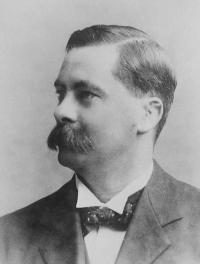Papers, etc.
Some of Turner’s letters are at the History of Science Museum, Oxford and at University College, London, and many are at the Royal Astronomical Society. There is much Turner-Hale correspondence in the Hale microfilms.
Other References: Historical
Search ADS for works about Turner.
Adam, M.G., “The Changing Face of Astronomy in Oxford (1920-1960),” QJRAS 37, 153-79 (1996).
Bellamy, Frank Arthur, “The International Photographic Survey of the Sky,” Cheltenham Examiner, 1909.
Bellamy, F.A. & Ethel F. B., Herbert Hall Turner: A Notice of his Seismological Work (University Observatory, Oxford & The County Press, Newport, Isle of Wight, 1931).
Chinnici, Ileana, La Carte du Ciel: Correspondence inédite conservée dans les archives de l’Observatoire de Paris (Observatoire de Paris, Paris & Osservatorio Astronomico di Palermo, Palermo, 1999).
Dreyer, J. L. E. and H. H. Turner, eds, History of the Royal Astronomical Society, 1820-1920 (Royal Astronomical Society, London, 1923; reprinted by Blackwell Scientific Publications, 1987) [review by G.E. Hale in Ap.J. 62, 65-72 (1925)].
Dyson, F.W., “The Distribution in Space of the Stars in Carrington’s Circumpolar Catalogue,” MNRAS 73, 334-45 (1913) [in a footnote on p. 342 Dyson credits Turner with suggesting the word parsec].
Fotheringham, J.K., “Astronomy in Oxford,” Oxford Magazine, 1930.
Harris, B.J., “Standard Co-ordinates,” Observatory 72, 73-74 (1952).
Higgitt, Rebekah, “Cosmic Diary: Greenwich 1894”
http://cosmicdiary1894.blogspot.com/
Kidwell, Peggy A., “Women Astronomers in Britain, 1780-1930,” Isis 75, 534-46 (1984).
Turner, Herbert Hall, Miscellaneous Papers of the University Observatory, Oxford, vol. I, 1899-1902, preface, p. 1-9.
Turner, Herbert Hall, “From an Oxford Notebook,” [Delightful notes of travel to the St. Louis Congress of Arts & Sciences, including visits to Harvard, Dudley, Yerkes, Mt. Wilson, and Lick Observatories] Observatory 27, 323-25 (1904); 27, 354-58 (1904); 27, 383-90 (1904); 27, 417-22 (1904); 27, 458-62 (1904); 28, 72-76 (1905) and 28, 115-20 (1905).
Wright, Helen, Explorer of the Universe: A Biography of George Ellery Hale (Dutton, 1966).
Other References: Scientific
Search ADS for works by Turner
Turner, H.H., “How to Obtain a Star’s Right Ascension and Declination from a Photograph,” Observatory 16, 373-76 (1893).
Turner, Herbert Hall, ”Preliminary Note on the Reduction of Measures of Photographic Plates,” MNRAS 54, 11-25 (1893).
Turner, H.H., “On the Reduction of Astronomical Photographs,” Observatory 17, 141-42 (1894).
Turner, Herbert Hall, The Astrographic Chart and Astrographic Methods (Royal Engineers Inst., Chatham, UK, 1903).
Turner, Herbert Hall, Astrographic catalogue 1900-0 Oxford section dec. +24° to +32°: from photographs taken and measured at the University observatory, Oxford, under the direction of Herbert Hall Turner, vol. I (1906) – vol. VIII (1913) (University Observatory, Oxford).
Other Works: Popularizations, History, etc.
Turner, Herbert Hall, “The New Star in Gemini,” Royal Institution Library of Science: Astronomy, 36-46. (lecture delivered 5 June 1903)
Turner, Herbert Hall, “Some Reflections suggested by the Application of Photography to Astronomical Research,” Address at the Congress of Arts and Sciences, St. Louis, Sept. 21, 1904. Observatory 27, 391-99 (1904) and 27, 442-48 (1904).
Turner, H.H., Astronomical Discovery (Edward Arnold, London, 1904; Univ. of California Press, Berkeley, 1963). [Review by Charles A. Young]
Turner, Herbert Hall, Modern Astronomy: Being Some Account of the Revolution of the Last Quarter of a Century (Constable & Co., Ltd., 1909).
Turner, H.H., Halley’s Comet; An Evening Discourse to the British Association at Their Meeting at Dublin, on Friday, September 4, 1908 (Clarendon Press, Oxford, 1910).
Turner, Herbert Hall, The Great Star Map, Being a Brief General Account of the International Project Known as the Astrographic Chart (John Murray, London, 1912).
Turner, H.H., A Voyage in Space: A Course of Six Lectures “Adapted to a Juvenile Auditory” Delivered at the Royal Institution at Xmas 1913 (Society for Promoting Christian Knowledge, London, 1915).
Dyson, F.W. & H.H. Turner, “The Commencement of the Astronomical Day,” Observatory 40, 301 (1917).
Turner, Herbert Hall, “Giant Suns,” Scientific Monthly 11, 228-34 (1920). [lecture delivered to the Royal Institution Library of Science 31 Jan 1919]
Turner, Herbert Hall, “The Oldest Astronomers Known,” PASP 41, 291-96 (1929).
